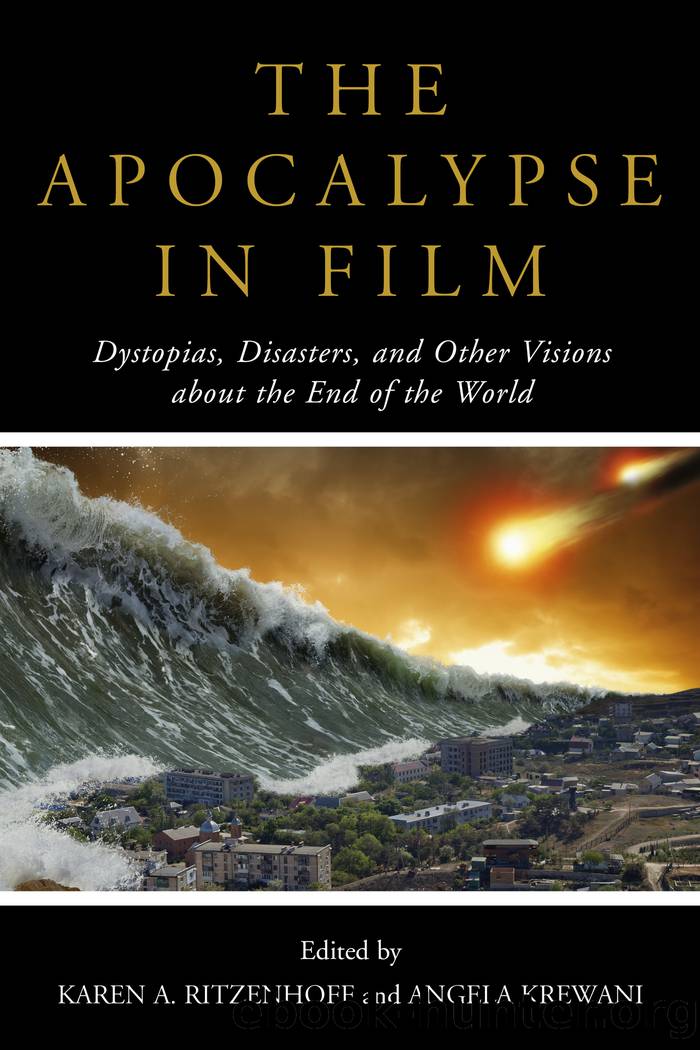The Apocalypse in Film by Ritzenhoff Karen A.;Krewani Angela;

Author:Ritzenhoff, Karen A.;Krewani, Angela;
Language: eng
Format: epub
Tags: undefined
Publisher: Rowman & Littlefield Publishers
Published: 2012-08-15T00:00:00+00:00
The Cinematic Eco-Apocalypse
Yet if the narrative of eco-apocalypse seems limited as a directly political resource, its continuing cinematic reiteration suggests that it has considerable popular cultural resonance. Indeed, we would suggest that cinematic eco-apocalypse is appealing to the contemporary imagination partly because it is antipolitical, allowing the frustrations and difficulties of political engagement to be swept aside. More precisely, in both The Day after Tomorrow and The Age of Stupid, we identify three themes: first, the sphere of conventional, formal politics is rejected as dysfunctional and/or negative; second, large-scale transformative agency is disavowed and instead projected into nature; and third, as a consequence, human âagencyâ is reduced to individualized, small-scale actions that are therapeutic in character.
One of the basic insights of modern left-wing politics was that the problems facing humanity were social rather than natural in origin and that they could, therefore, potentially be resolved through collective social action. With large-scale social change off the political agenda in Western societies for the time being, it is much harder to hold on to the insight that our problems are social in origin and solution. Political agency is now very narrowly associated with governments and disconnected politicians, who are represented negatively in both films. The Age of Stupid offers reductive caricatures of politics and economics, for example, in a short animated sequence that presents the history of modernity as a series of failed â-ismsâ ending with âconsumerism.â Political agency is also represented in the attempts of one individual to gain permission from his local council to build a wind farm. His anger and frustration with the political system is clear when his proposal is rejected through the actions of an organized group of âNIMBYâ (not in my backyard) residents.
In The Day after Tomorrow, a negative portrayal of formal political agency is embodied in the dismissive and belligerent Vice President Becker (a character clearly modeled on the unpopular Dick Cheney). The vice president refuses to listen to the scientific evidence presented by the filmâs hero until it is too late to act. Catastrophic weather events destroy not only the physical human environment but also the prevailing social order: survivors of the US administration take refuge in Mexico. By the end of the film, a humbled and penitent vice president is forced to admit that he was wrong and, by extension, that the whole social order he represents was flawed, mistakenly believing that it could use natureâs resources without consequences.
In both The Day after Tomorrow and The Age of Stupid, then, there is a clear sense that the destruction is deserved as a kind of punishment for past sins or stupidities. As John Walliss and James Aston observe, this is characteristic of the kind of âsocial commentaryâ found in several apocalyptic filmsâother examples include Children of Men (2006), The Day the Earth Stood Still (2008), and Knowing (2009)âwhereby the existing sociopolitical order is simply wiped out in order to allow a fresh start, and any hope for the future is vested in the innocence of childhood as against the corrupt adult world.
Download
This site does not store any files on its server. We only index and link to content provided by other sites. Please contact the content providers to delete copyright contents if any and email us, we'll remove relevant links or contents immediately.
How To Write A Damn Good Thriller by James N. Frey(393)
Naked as Nature Intended by Pamela Green(372)
30 Movies to Get You Through the Holidays by Roger Ebert(364)
Bond, James Bond by Brad Gilmore(306)
It's Only a Movie! by Haberski Jr. Raymond J(296)
Chinese films in focus II by Unknown(260)
The Fellowship of the Knits: Lord of the Rings: The Unofficial Knitting Book by Tanis Gray(249)
How To Write A Novel The Easy Way Using The Pulp Fiction Method To Write Better Novels: Writing Skills by Jim Driver(240)
The Greatest Show on Earth by Jerry Pinto(230)
Smartphone Cinema: Making Great Films with Your Mobile Phone by Bart Weiss(218)
Film Truth; November, 1920 by Anonymous(218)
The Garden in the Machine by Unknown(213)
The Reel Truth by Reed Martin(206)
Charles McGraw by Alan K. Rode(205)
Jurassic Park and Philosophy by Watkins Jessica Michaud Nicolas(204)
Thomas Mann and Friedrich Nietzsche: Eroticism, Death, Music, and Laughter by Caroline Joan Picart(204)
Jafar Panahi: Interviews by Unknown(201)
The Japanese Cinema Book by Hideaki Fujiki & Alastair Phillips(198)
Euro-Visions: Europe in Contemporary Cinema by Mariana Liz(194)
